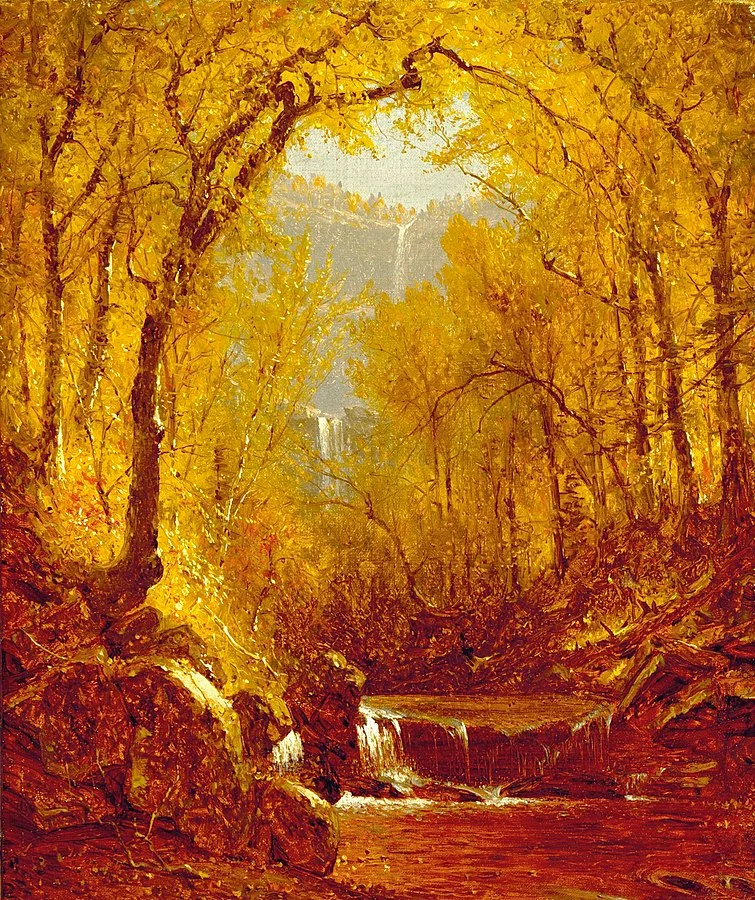
Even though Robert Frost was born in California, he is known as a quintessentially New England Poet. His family roots were there and he spent most of his life there, but what perhaps marks him best as a New England poet is his style: pithy, clear, unadorned – without either the floridity of Victorian verse or the open-ended image-sequences of modernism. But brevity and clarity should never be mistaken for shallowness. Frost’s verse is as deep as it is easy to digest.
“Nothing Gold Can Stay” from his 1923 volume New Hampshire is both a famous and particularly illustrative example of how Frost achieves a depth of analysis packed into a paucity of verses. The entire poem reads:
Nothing Gold Can Stay
Nature’s first green is gold,
Her hardest hue to hold.
Her early leaf’s a flower;
But only so an hour.
Then leaf subsides to leaf.
So Eden sank to grief,
So dawn goes down to day.
Nothing gold can stay.
Stylistically, this is characteristic Frost. The language is simple, even laconic; the poem consists of eight lines, five sentences, forty words – all monosyllables except for seven disyllables. The tone is direct, conversational, easily comprehensible. Frost has no use for rhetorical flourishes, Latinate syntax, or emotive effusions. It is the voice of a stereotypical New England Yankee, heir to the Puritans: nothing fancy.
Structurally, the poem is formal, written in loose iambic trimeter, with the rhyme occurring in four sets of couplets. Again, this is quintessential Frost, maintaining formal conventions at a time when form-averse modernism was the overwhelmingly dominant trend in poetry.
The meaning contained in the poem, however, is anything but simple or formalistic. It is in the use of poetic metaphor that Frost here demonstrates his poetic genius. True to his poetic theory, Frost constructs the poem around a central metaphor: not even an object, but a color, specifically the golden hue of germinating vegetation.
The color is a metaphor for fleeting youth and all it entails. Lost with youth are innocence (“Eden sank to grief”) and hope (“dawn goes down to day”). Though the plant continues to live and grow (“leaf subsides to leaf”), that first golden hue is forever lost. The color gold, too, may allude to the Golden Age of Classical mythology, a vanished age of peace and plenty when labor, suffering, and crime were unknown. The lost ideal age has the same color as the lost youth as idealized from the viewpoint of one having lost it.
“Nothing Gold Can Stay” perfectly encapsulates Frost’s maxim that “a poem begins in delight and ends in wisdom.” It begins in wonder, delighting in the often-unnoticed gold of sprouting vegetation and as it observes and mourns the gold’s disappearance, it achieves wisdom through metaphor, likening the lost golden hue to the fleetingness of youth and all its loss implies.
But what is the wisdom gained? Is it simply that youth quickly flees? That is almost a poetic truism. There is something deeper in Frost’s poem, and it is not readily apparent at first glance. It has to be gleaned from the lines. The gold turns into the green of burgeoning leaves. The dawn yields to the day of full sunlight. Eden sinks to the grief of which St. Augustine exclaimed, “O happy fault! O necessary sin of Adam which gained for us so great a Redeemer!”
Frost’s gold does not decay, but grows into something fuller. With lost youth comes gained wisdom. And while the fleeting gold is beautiful, it yields to something fuller, more developed and complete. And while Frost’s tone is tinged with mourning for the loss of the gold, the poem is far from a lamentation, for it recognizes in the loss a necessary growth into maturity – into the being the youth is intended to become. The imparting of wisdom that necessarily accompanies the loss of youth is itself, therefore, the wisdom that Frost imparts. And the wisdom is a green that does not fade as the gold.
Adam Sedia (b. 1984) lives in his native Northwest Indiana, with his wife, Ivana, and their two children, and practices law as a civil and appellate litigator. In addition to the Society’s publications, his poems and prose works have appeared in The Chained Muse Review, Indiana Voice Journal, and other literary journals. He is also a composer, and his musical works may be heard on his YouTube channel.